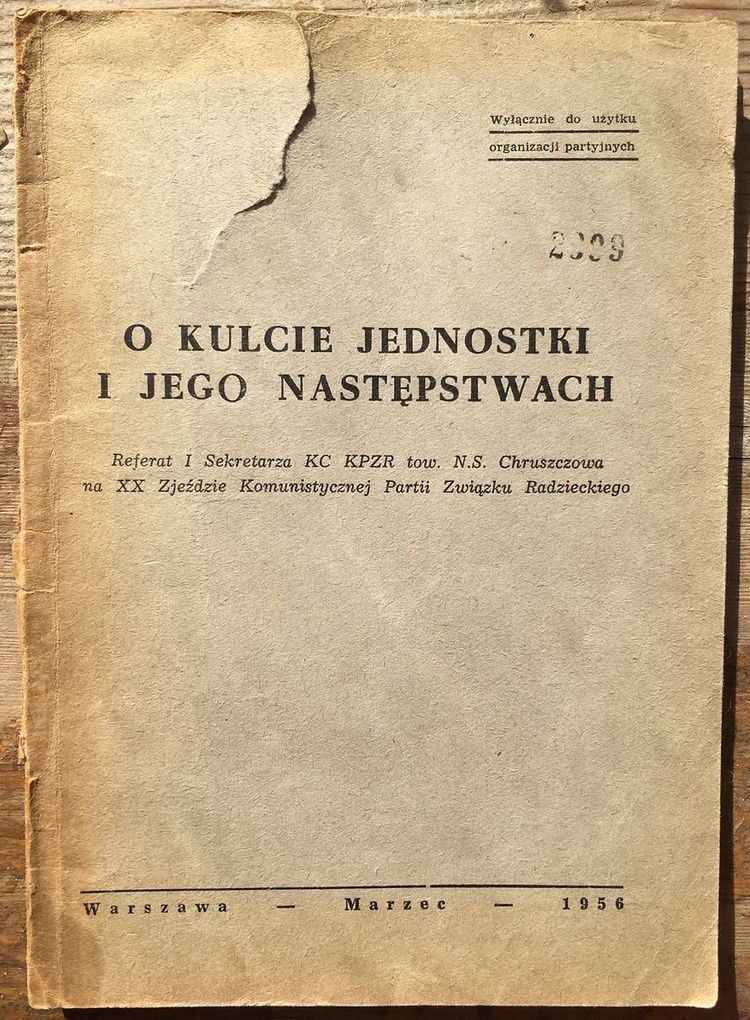 | ||
De-Stalinization (Russian: десталинизация, Destalinizatsiya) was a political reform in the Soviet Union after the death of long-time leader Joseph Stalin in 1953. The reforms consisted of changing or removing key institutions that helped Stalin hold power: the cult of personality that surrounded him, the Stalinist political system, and the Gulag labour-camp system, all of which had been created and dominated by him. Stalin was succeeded by a collective leadership after his death in March 1953, consisting of Georgi Malenkov, Premier of the Soviet Union; Lavrentiy Beria, head of the Ministry of the Interior; and Nikita Khrushchev, First Secretary of the Central Committee of the Communist Party of the Soviet Union (CPSU).
Contents
- Beginnings Khrushchevs speech
- Improved prison conditions
- Re naming of places and buildings
- Destruction of monuments
- Re location of Stalins body
- References
Contemporary historians regard the beginning of de-Stalinization as a significant turning point in the history of the Soviet Union. It began during the Khrushchev Thaw. However, it subsided during the Brezhnev period and remained so until the mid-1980s, when it accelerated once again due to policies of perestroika and glasnost under Mikhail Gorbachev.
Beginnings: Khrushchev's speech
De-Stalinization meant an end to the role of large-scale forced labour in the economy. The process of freeing Gulag prisoners was started by Lavrentiy Beria. He was soon removed from power (arrested on June 26, 1953; executed on December 24, 1953) and Nikita Khrushchev then emerged as the most powerful Soviet politician.
While De-Stalinization was quietly underway ever since Stalin's death, the watershed event was Khrushchev's speech entitled "On the Cult of Personality and Its Consequences", concerning Stalin. On 25 February 1956, he spoke to a closed session of the Twentieth Party Congress of the Communist Party of the Soviet Union. Khrushchev thoroughly shocked his listeners by denouncing Stalin's dictatorial rule and his cult of personality as inconsistent with communist and Party ideology. Among other points, he condemned the treatment of the Old Bolsheviks, people who had supported communism before the revolution, many of whom Stalin had executed as traitors. Khrushchev also attacked the crimes committed by associates of Beria.
Improved prison conditions
Khrushchev also attempted to make the Gulag labour system less harsh, by allowing prisoners to post letters home to their families, and by allowing family members to mail clothes to loved-ones in the camps, which was not allowed during Stalin's time. Furthermore, when Stalin died, the Gulag was "radically reduced in size." On October 25, 1956, a resolution of the CPSU declared that the existence of the Gulag labour system was "inexpedient". The Gulag institution was closed by the MVD order No 020 of 25 January 1960.
Re-naming of places and buildings
As part of the de-Stalinization push, Khrushchev endeavored to have many places bearing Stalin's name renamed or reverted to their former names, including cities, landmarks, and other facilities. These included even capital cities of the Soviet republics and territories: in 1961, Stalinabad, capital of the Tajikistan, was renamed Dushanbe; Staliniri, capital of the South Ossetian Autonomous Oblast, was renamed Tskhinvali; and Stalingrad, a major industrial center of the Russian Soviet Federative Socialist Republic, was renamed Volgograd. In Ukraine, the Stalino Oblast and its capital, also named Stalino, were renamed Donetsk Oblast and Donetsk.
In a symbolic gesture, the State Anthem of the Soviet Union was purged of references to Stalin. The Stalin-centric and World War II-era lines in the lyrics were effectively excised when an instrumental version replaced it.
The Joseph Stalin Palace of Culture and Science in Warsaw, Poland was renamed in 1956.
Destruction of monuments
The Yerevan monument was removed in spring 1962 and replaced by Mother Armenia in 1967. Thousands of Stalin monuments have been destroyed not only in the Soviet Union but in Socialist countries. In November 1961 the large Stalin Statue on Berlin's monumental Stalinallee (promptly renamed Karl-Marx-Allee) was removed in a clandestine operation. The Monument in Budapest was destroyed in October 1956. The biggest one, the Prague monument, was taken down in November 1962.
Re-location of Stalin's body
Given momentum by these public renamings, the process of de-Stalinization peaked in 1961 during the 22nd Congress of the CPSU. Two climactic acts of de-Stalinization marked the meetings: first, on October 31, 1961, Stalin's body was moved from Lenin's Mausoleum in Red Square to a location near the Kremlin wall; second, on November 11, 1961, the "hero city" Stalingrad was renamed Volgograd.
